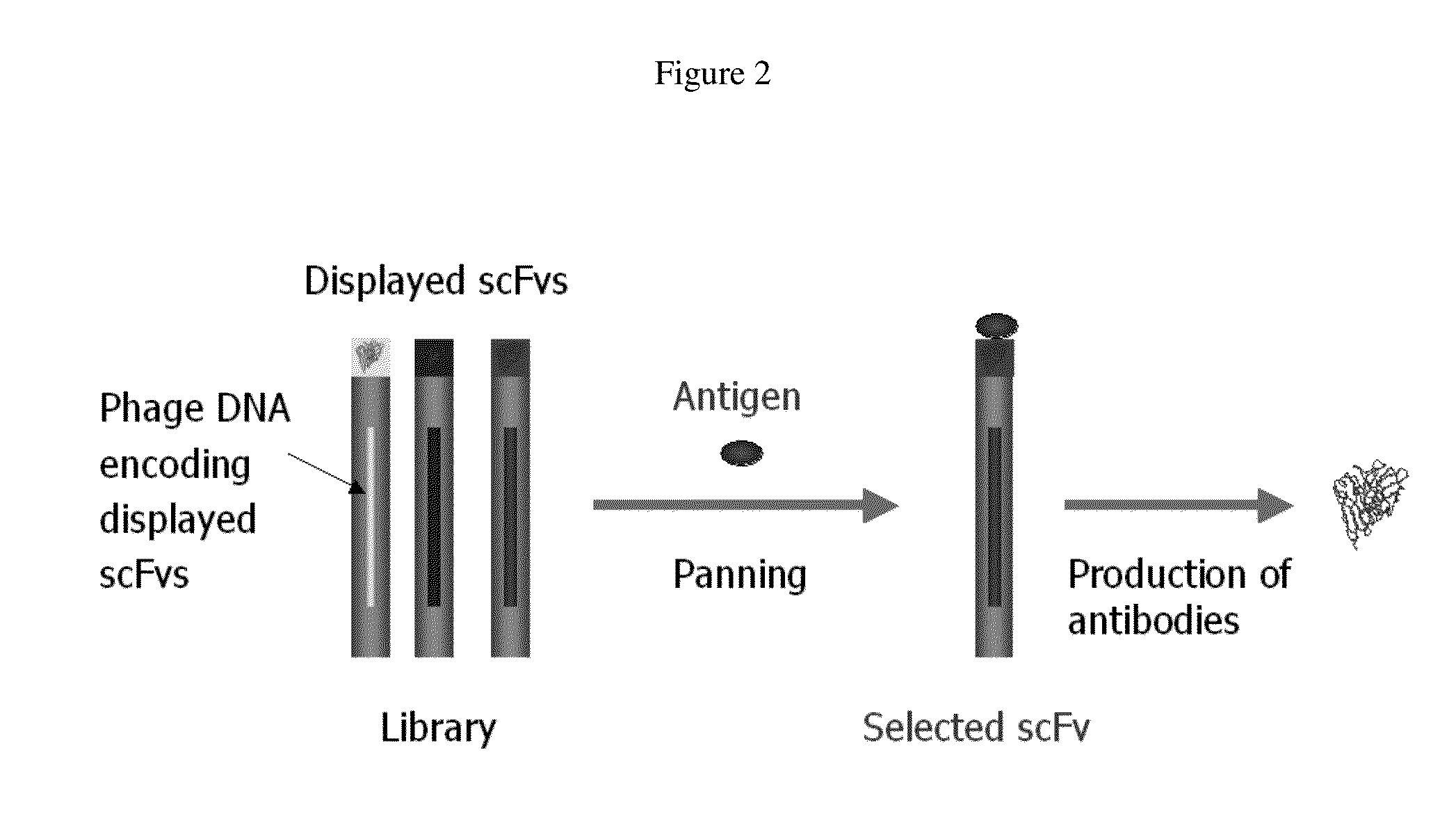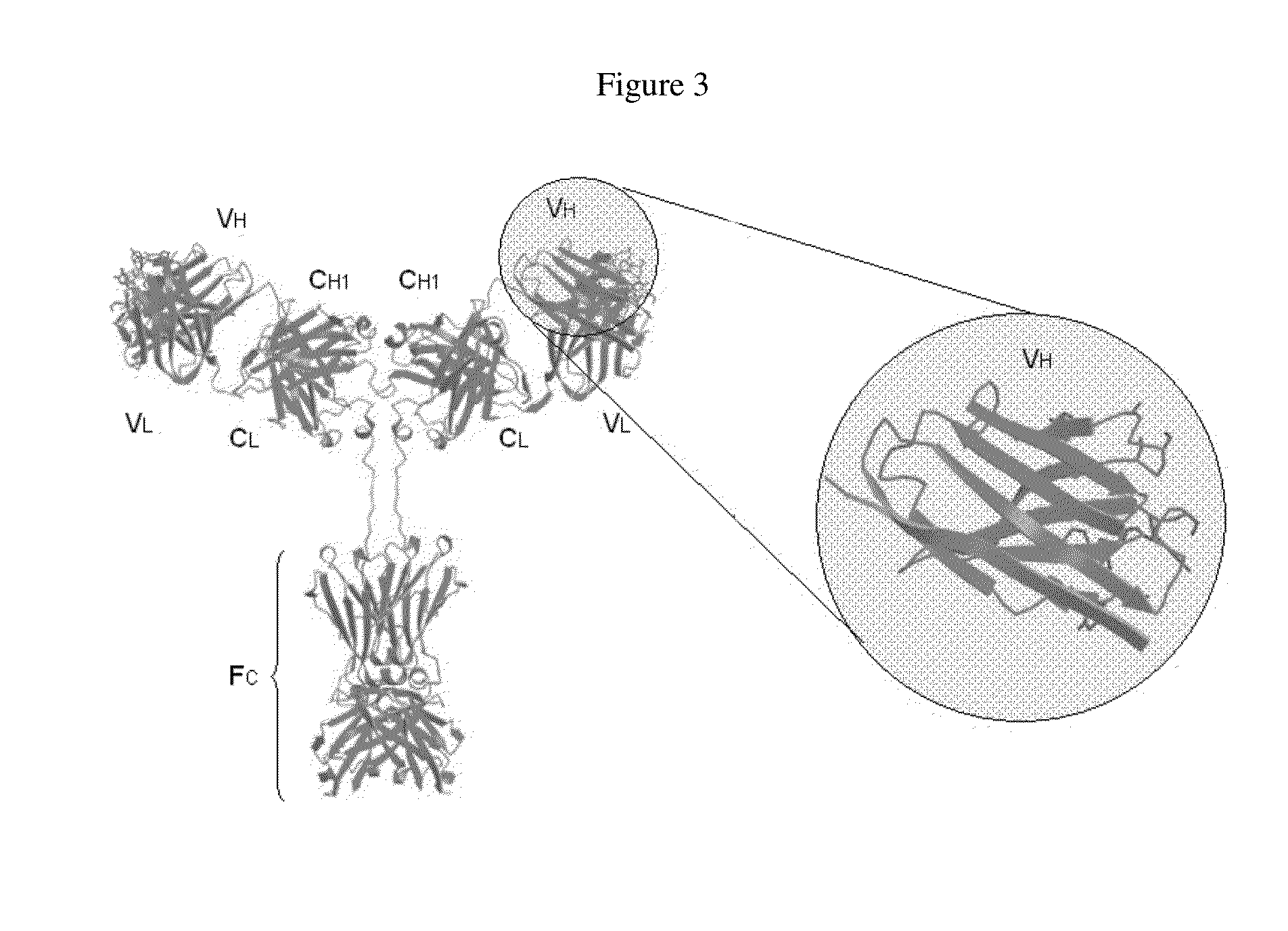Anti-hiv domain antibodies and method of making and using same
a domain antibody and antibody technology, applied in the field of domain antibodies, can solve the problems of virus's innate ability to escape, no mabs have been approved for clinical use against hiv-1, and the potency of 2f5 and 2g12 used in combination in this clinical trial was significantly lower, and achieves poor stability, solubility and effectiveness. , the effect of high affinity for the target epitop
- Summary
- Abstract
- Description
- Claims
- Application Information
AI Technical Summary
Benefits of technology
Problems solved by technology
Method used
Image
Examples
example 1
Identification of VH Framework
[0226]A naïve human Fab library (1.5×1010 members) was constructed from peripheral blood B cells of 22 healthy donors, spleens of 3 donors, and lymph nodes of healthy 34 donors. This library was used for selection of Fabs against HIV-1 antigen gp140 which was conjugated to magnetic beads (Dynabeads M-270 epoxy; DYNAL Inc., New Hyde Park, N.Y.) as described (Zhu Z et al. J Virol. 2006, 80(2):891-9). Amplified libraries of 3.8×1012 phage-displayed Fabs were incubated with 20, 20, 10, and 10 μg of gp140 in 1 ml volume for 2 h at room temperature during the first, second, third, and fourth rounds of biopanning, respectively. After incubation the beads were washed 5 times for the first round and 10 times for the later rounds with PBST to remove nonspecifically bound phages. Bound phages were rescued by mixing the beads with E. coli TG1 cells for 45 min at 37° C. and a phage library was prepared for the next round of biopanning. Ninety five clones were random...
example 2
Results
[0406]Design of the VH Library
[0407]To obtain a diverse VH library, an approach that grafts all three CDRs from several sources to the framework scaffold of m0 could have been taken. However, the estimated diversity of such an approach could be more than 1012 after recombination among three CDRs, which is difficult for artificially created phage display libraries to reach. This Example took the approach of mutating one of the CDRs, while grafting in the remaining CDRs from a variety of different sources. Given that the CDR1s were relatively more conserved in both their sequences and their lengths, this Example focused on grafting in CDR2s and CDR3s from a variety of sources, while randomly mutating four putative solvent-accessible positions of the CDR1 of m0 to A / D / S / Y (the solvent-accessible positions being amino acid residue #27, 29, 31 and 32 under the IMGT numbering system) (see FIGS. 5A and 5B) in the original CDR1 of m0 to A / D / S / Y.
[0408]In order to access as many differ...
example 3
Human Domain Antibodies to Conserved Sterically Restricted Regions on Gp120 as Exceptionally Potent Cross-Reactive HIV-1 Neutralizers
[0450]This Examples describes the identification and characterization of an antibody heavy chain variable domain (VH) (domain antibody, dAb), m36, targeting highly conserved but sterically restricted CD4-induced (CD4i) structures on the Env. It is believed that M36 is the first reported representative of a novel class of potent and broadly cross-reactive HIV-1 inhibitors based on human dAbs. It has potential as a candidate therapeutic and a microbicide, and as an agent for exploration of the highly protected conserved Env structures with implications for the design of novel small molecule inhibitors, and elucidation of the mechanisms of virus entry into cells and evasion of immune responses.
[0451]The following methods and materials were employed in this Example. The results of this Example are subsequently discussed below.
[0452]Methods and Materials:
[0...
PUM
| Property | Measurement | Unit |
|---|---|---|
| dissociation constant | aaaaa | aaaaa |
| concentration | aaaaa | aaaaa |
| dissociation constant | aaaaa | aaaaa |
Abstract
Description
Claims
Application Information
 Login to View More
Login to View More - R&D
- Intellectual Property
- Life Sciences
- Materials
- Tech Scout
- Unparalleled Data Quality
- Higher Quality Content
- 60% Fewer Hallucinations
Browse by: Latest US Patents, China's latest patents, Technical Efficacy Thesaurus, Application Domain, Technology Topic, Popular Technical Reports.
© 2025 PatSnap. All rights reserved.Legal|Privacy policy|Modern Slavery Act Transparency Statement|Sitemap|About US| Contact US: help@patsnap.com



